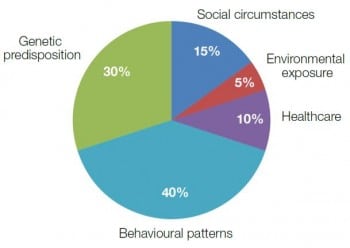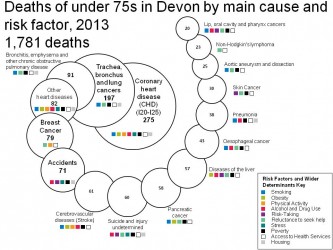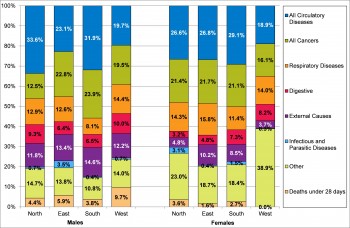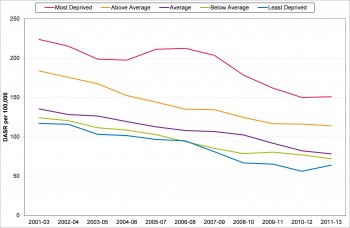There are a range of factors that contribute to premature death as shown in figure 9.3. Behavioural patterns are important and a leading cause but the confounding social circumstances are significant. Interestingly healthcare is less significant but it is essential healthcare is accessed when appropriate and necessary to do so including access for immunisation and screening programmes.
Figure 9.3, Factors contributing to premature death in England

Source: ‘Evidence into action: opportunities to protect and improve the nation’s health’, Public Health England. October 2014
The following figure looks at the underlying causes of death for people aged under 75 in Devon during 2013 with coloured dots to illustrate the wider risk factors associated with these conditions. There were 1,781 deaths under the age of 75 in 2013, of which the largest underlying causes were heart diseases, lung cancer, respiratory conditions, breast cancer and accidents. The following observations can be made about risk factors:
- Poverty – Health inequalities are apparent for virtually all causes of death, with people living in poverty more likely to die younger
- Access to Health Services – Timely and appropriate access to health services can be a major factor in premature death
- Housing – Housing conditions are associated with premature death and are a particular factor when it comes to respiratory conditions and accidents
- Smoking – Smoking is the behaviour with the strongest association with premature death, particular in relation to heart disease, lung cancer and respiratory conditions
- Obesity and Physical Activity– Obesity and Physical activity are risk factors for premature death, particularly in relation to heart disease and stroke
- Alcohol and Drug Use – Substance misuse increases the likelihood of premature death, both from health conditions, and due to accidents or suicide
- Risk Taking – Risky sexual behaviours, dangerous driving, and failing to protect yourself in the sun, can increase the likelihood of premature death
- Reluctance to Seek Help – A reluctance to seek help from health professionals can lead to later detection of disease and a greater likelihood of ill health and death
- Stress – Stress is a risk factor associated with both physical and mental conditions.
Figure 9.4, Deaths of under 75s in Devon by main cause and associated risk factors, 2013

Source: Primary Care Mortality Database, 2014
As noted above, poverty is a major factor in premature mortality. On average there is a 5.2 year gap in male life expectancy and a 3.3 year gap in female life expectancy between the most and least deprived communities in Devon. Figure 9.5 highlights the conditions contributing to this gap by area. Whilst mortality rates from preventable conditions have fallen, the gap still persists between areas of the county as shown in figure 9.6.
Figure 9.5, Conditions contributing to the life expectancy gap by area, Devon, 2013

Source: Primary Care Mortality Database, 2014
Figure 9.6, Mortality rates from conditions considered amenable to healthcare by Index of Multiple Deprivation quintile, Devon, 2001-03 to 2011-13

Source: Primary Care Mortality Dataset 2014